对象
对象, 在C语言是如何实现的?
Python中对象分为两类: 定长(int等), 非定长(list/dict等)
所有对象都有一些相同的东西, 源码中定义为PyObject和PyVarObject, 两个定义都有一个共同的头部定义PyObject_HEAD(其实PyVarObject有自己的头部定义PyObject_VAR_HEAD, 但其实际上用的也是PyObject_HEAD).
源码位置: Include/object.h
PyObject_HEAD
Python 内部, 每个对象拥有相同的头部.
定义
/* PyObject_HEAD defines the initial segment of every PyObject. */ #define PyObject_HEAD \ _PyObject_HEAD_EXTRA \ Py_ssize_t ob_refcnt; \ struct _typeobject *ob_type;
说明
1. _PyObject_HEAD_EXTRA
先忽略, 双向链表结构, 后面垃圾回收再说
2. Py_ssize_t ob_refcnt
Py_ssize_t在编译时确定, 整型
ob_refcnt, 引用计数, 跟Python的内存管理机制相关(基于引用计数的垃圾回收)
3. struct _typeobject *ob_type
*ob_type 指向类型对象的指针(指向_typeobject结构体)
决定了这个对象的类型!
PyObject
定义
typedef struct _object {
PyObject_HEAD
} PyObject;
说明
1. 依赖关系
PyObject -> PyObject_HEAD
结构
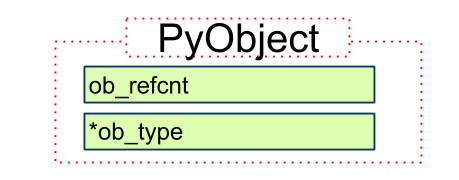
PyVarObject
定义
typedef struct {
PyObject_VAR_HEAD
} PyVarObject;
#define PyObject_VAR_HEAD \
PyObject_HEAD \
Py_ssize_t ob_size; /* Number of items in variable part */
说明
1. 依赖关系
PyVarObject -> PyObject_VAR_HEAD -> PyObject_HEAD
2.Py_ssize_t ob_size
ob_size, 变长对象容纳的元素个数
结构
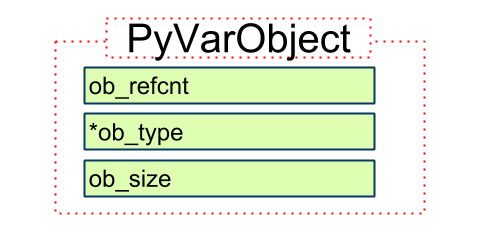
代码关系
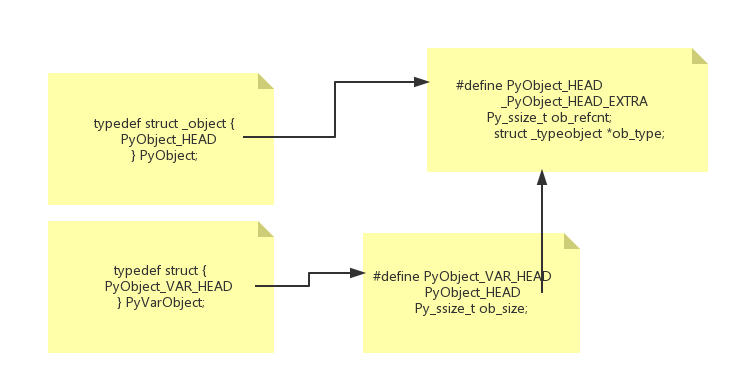
几个方法
跟对象相关的方法
#define Py_REFCNT(ob) (((PyObject*)(ob))->ob_refcnt)
读取引用计数
#define Py_TYPE(ob) (((PyObject*)(ob))->ob_type)
获取对象类型
#define Py_SIZE(ob) (((PyVarObject*)(ob))->ob_size)
读取元素个数(len)
跟引用计数相关的方法
Py_INCREF(op) 增加对象引用计数
Py_DECREF(op) 减少对象引用计数, 如果计数位0, 调用_Py_Dealloc
_Py_Dealloc(op) 调用对应类型的 tp_dealloc 方法(每种类型回收行为不一样的, 各种缓存池机制, 后面看)
其他
几个参数涉及
ob_refcnt 引用计数, 与内存管理/垃圾回收相关
ob_type 类型, 涉及Python的类型系统
类型
一个例子
>>> a = 1 >>> a 1 >>> type(a) <type 'int'> #等价的两个 >>> type(type(a)) <type 'type'> >>> type(int) <type 'type'> #还是等价的两个 >>> type(type(type(a))) <type 'type'> >>> type(type(int)) <type 'type'>
我们反向推导一个int对象是怎么生成的.
1. 首先, 定义一种类型叫PyTypeObject
代码位置 Include/object.h
定义
typedef struct _typeobject {
/* MARK: base, 注意, 是个变长对象*/
PyObject_VAR_HEAD
const char *tp_name; /* For printing, in format "<module>.<name>" */ //类型名
Py_ssize_t tp_basicsize, tp_itemsize; /* For allocation */ // 创建该类型对象时分配的内存空间大小
// 一堆方法定义, 函数和指针
/* Methods to implement standard operations */
printfunc tp_print;
hashfunc tp_hash;
/* Method suites for standard classes */
PyNumberMethods *tp_as_number; // 数值对象操作
PySequenceMethods *tp_as_sequence; // 序列对象操作
PyMappingMethods *tp_as_mapping; // 字典对象操作
// 一堆属性定义
....
} PyTypeObject;
说明
1. PyObject_VAR_HEAD
变长对象
2. const char *tp_name
tp_name, 类型名字符串数组
所有Type都是PyTypeObject的"实例": PyType_Type/PyInt_Type
2. 然后, 用PyTypeObject初始化得到一个对象PyType_Type
代码位置 Objects/typeobject.c
定义
PyTypeObject PyType_Type = {
PyVarObject_HEAD_INIT(&PyType_Type, 0)
"type", /* tp_name */
sizeof(PyHeapTypeObject), /* tp_basicsize */
sizeof(PyMemberDef), /* tp_itemsize */
(destructor)type_dealloc, /* tp_dealloc */
// type对象的方法和属性初始化值
.....
};
说明
1. tp_name
类型名, 这里是"type"
2. PyVarObject_HEAD_INIT(&PyType_Type, 0)
PyVarObject_HEAD_INIT, 这个方法在 Include/object.h中,
等价于
ob_refcnt = 1
*ob_type = &PyType_Type
ob_size = 0
即, PyType_Type的类型是其本身!
结构
第一张图, 箭头表示实例化(google doc用不是很熟找不到对应类型的箭头)
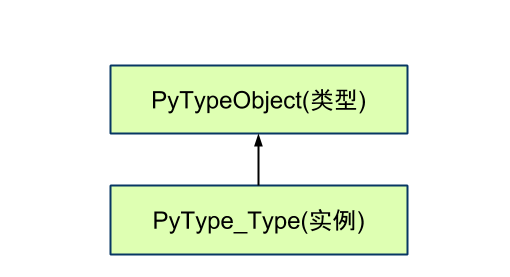
第二张图, 箭头表示指向
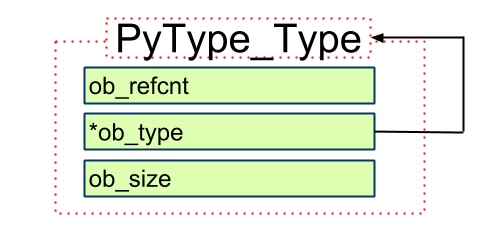
使用
# 1. int 的 类型 是`type` >>> type(int) <type 'type'> # 2. type 的类型 还是`type`, 对应上面说明第二点 >>> type(type(int)) <type 'type'>
注意: 无论任何时候, ob_type指向的是 PyTypeObject的实例: PyType_Type/PyInt_Type...
3. 再然后, 定义具体的类型, 这里以PyInt_Type为例子
代码位置 Objects/intobject.c
定义
PyTypeObject PyInt_Type = {
PyVarObject_HEAD_INIT(&PyType_Type, 0)
"int",
sizeof(PyIntObject),
0,
// int类型的相关方法和属性值
....
(hashfunc)int_hash, /* tp_hash */
};
说明
1. "int"
PyInt_Type的类型名是int
2.PyVarObject_HEAD_INIT(&PyType_Type, 0)
PyInt_Type的
*ob_type = &PyType_Type
结构

使用
>>> type(1) <type 'int'> >>> type(type(1)) <type 'type'>
4. 最后, 生成一个整数对象int
代码位置 Include/intobject.h
定义
typedef struct {
PyObject_HEAD
long ob_ival;
} PyIntObject;
结构
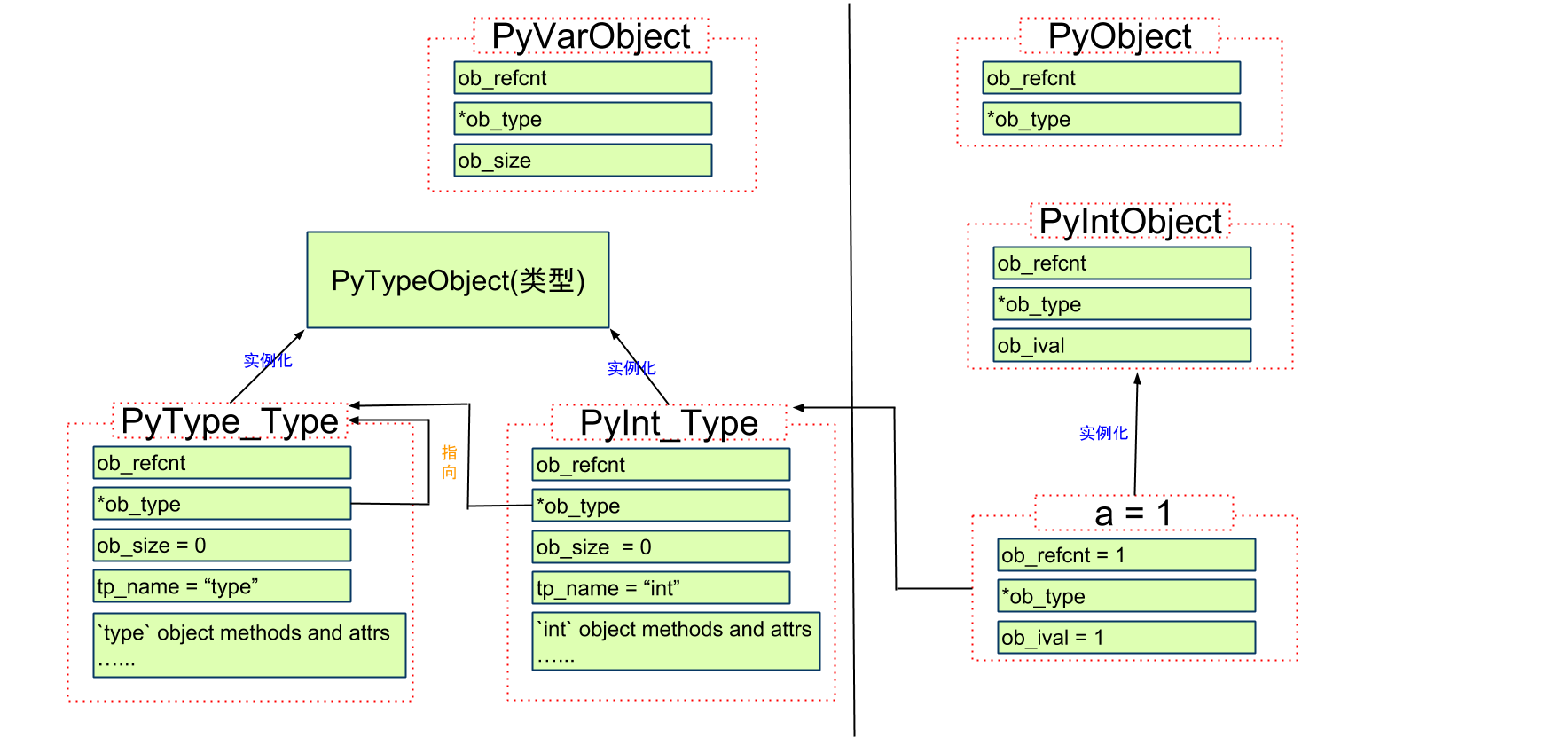
 Python vs C: Memahami perbezaan utamaApr 21, 2025 am 12:18 AM
Python vs C: Memahami perbezaan utamaApr 21, 2025 am 12:18 AMPython dan C masing -masing mempunyai kelebihan sendiri, dan pilihannya harus berdasarkan keperluan projek. 1) Python sesuai untuk pembangunan pesat dan pemprosesan data kerana sintaks ringkas dan menaip dinamik. 2) C sesuai untuk prestasi tinggi dan pengaturcaraan sistem kerana menaip statik dan pengurusan memori manual.
 Python vs C: Bahasa mana yang harus dipilih untuk projek anda?Apr 21, 2025 am 12:17 AM
Python vs C: Bahasa mana yang harus dipilih untuk projek anda?Apr 21, 2025 am 12:17 AMMemilih Python atau C bergantung kepada keperluan projek: 1) Jika anda memerlukan pembangunan pesat, pemprosesan data dan reka bentuk prototaip, pilih Python; 2) Jika anda memerlukan prestasi tinggi, latensi rendah dan kawalan perkakasan yang rapat, pilih C.
 Mencapai matlamat python anda: kekuatan 2 jam sehariApr 20, 2025 am 12:21 AM
Mencapai matlamat python anda: kekuatan 2 jam sehariApr 20, 2025 am 12:21 AMDengan melabur 2 jam pembelajaran python setiap hari, anda dapat meningkatkan kemahiran pengaturcaraan anda dengan berkesan. 1. Ketahui Pengetahuan Baru: Baca dokumen atau tutorial menonton. 2. Amalan: Tulis kod dan latihan lengkap. 3. Kajian: Menyatukan kandungan yang telah anda pelajari. 4. Amalan Projek: Sapukan apa yang telah anda pelajari dalam projek sebenar. Pelan pembelajaran berstruktur seperti ini dapat membantu anda menguasai Python secara sistematik dan mencapai matlamat kerjaya.
 Memaksimumkan 2 Jam: Strategi Pembelajaran Python BerkesanApr 20, 2025 am 12:20 AM
Memaksimumkan 2 Jam: Strategi Pembelajaran Python BerkesanApr 20, 2025 am 12:20 AMKaedah untuk belajar python dengan cekap dalam masa dua jam termasuk: 1. Semak pengetahuan asas dan pastikan anda sudah biasa dengan pemasangan Python dan sintaks asas; 2. Memahami konsep teras python, seperti pembolehubah, senarai, fungsi, dan lain -lain; 3. Menguasai penggunaan asas dan lanjutan dengan menggunakan contoh; 4. Belajar kesilapan biasa dan teknik debugging; 5. Memohon pengoptimuman prestasi dan amalan terbaik, seperti menggunakan komprehensif senarai dan mengikuti panduan gaya PEP8.
 Memilih antara python dan c: bahasa yang sesuai untuk andaApr 20, 2025 am 12:20 AM
Memilih antara python dan c: bahasa yang sesuai untuk andaApr 20, 2025 am 12:20 AMPython sesuai untuk pemula dan sains data, dan C sesuai untuk pengaturcaraan sistem dan pembangunan permainan. 1. Python adalah mudah dan mudah digunakan, sesuai untuk sains data dan pembangunan web. 2.C menyediakan prestasi dan kawalan yang tinggi, sesuai untuk pembangunan permainan dan pengaturcaraan sistem. Pilihan harus berdasarkan keperluan projek dan kepentingan peribadi.
 Python vs C: Analisis perbandingan bahasa pengaturcaraanApr 20, 2025 am 12:14 AM
Python vs C: Analisis perbandingan bahasa pengaturcaraanApr 20, 2025 am 12:14 AMPython lebih sesuai untuk sains data dan perkembangan pesat, manakala C lebih sesuai untuk prestasi tinggi dan pengaturcaraan sistem. 1. Sintaks Python adalah ringkas dan mudah dipelajari, sesuai untuk pemprosesan data dan pengkomputeran saintifik. 2.C mempunyai sintaks kompleks tetapi prestasi yang sangat baik dan sering digunakan dalam pembangunan permainan dan pengaturcaraan sistem.
 2 jam sehari: potensi pembelajaran pythonApr 20, 2025 am 12:14 AM
2 jam sehari: potensi pembelajaran pythonApr 20, 2025 am 12:14 AMAdalah mungkin untuk melabur dua jam sehari untuk belajar Python. 1. Belajar Pengetahuan Baru: Ketahui konsep baru dalam satu jam, seperti senarai dan kamus. 2. Amalan dan Amalan: Gunakan satu jam untuk melakukan latihan pengaturcaraan, seperti menulis program kecil. Melalui perancangan dan ketekunan yang munasabah, anda boleh menguasai konsep teras Python dalam masa yang singkat.
 Python vs C: Lengkung pembelajaran dan kemudahan penggunaanApr 19, 2025 am 12:20 AM
Python vs C: Lengkung pembelajaran dan kemudahan penggunaanApr 19, 2025 am 12:20 AMPython lebih mudah dipelajari dan digunakan, manakala C lebih kuat tetapi kompleks. 1. Sintaks Python adalah ringkas dan sesuai untuk pemula. Penaipan dinamik dan pengurusan memori automatik menjadikannya mudah digunakan, tetapi boleh menyebabkan kesilapan runtime. 2.C menyediakan kawalan peringkat rendah dan ciri-ciri canggih, sesuai untuk aplikasi berprestasi tinggi, tetapi mempunyai ambang pembelajaran yang tinggi dan memerlukan memori manual dan pengurusan keselamatan jenis.


Alat AI Hot

Undresser.AI Undress
Apl berkuasa AI untuk mencipta foto bogel yang realistik

AI Clothes Remover
Alat AI dalam talian untuk mengeluarkan pakaian daripada foto.

Undress AI Tool
Gambar buka pakaian secara percuma

Clothoff.io
Penyingkiran pakaian AI

Video Face Swap
Tukar muka dalam mana-mana video dengan mudah menggunakan alat tukar muka AI percuma kami!

Artikel Panas

Alat panas

Notepad++7.3.1
Editor kod yang mudah digunakan dan percuma

DVWA
Damn Vulnerable Web App (DVWA) ialah aplikasi web PHP/MySQL yang sangat terdedah. Matlamat utamanya adalah untuk menjadi bantuan bagi profesional keselamatan untuk menguji kemahiran dan alatan mereka dalam persekitaran undang-undang, untuk membantu pembangun web lebih memahami proses mengamankan aplikasi web, dan untuk membantu guru/pelajar mengajar/belajar dalam persekitaran bilik darjah Aplikasi web keselamatan. Matlamat DVWA adalah untuk mempraktikkan beberapa kelemahan web yang paling biasa melalui antara muka yang mudah dan mudah, dengan pelbagai tahap kesukaran. Sila ambil perhatian bahawa perisian ini

MantisBT
Mantis ialah alat pengesan kecacatan berasaskan web yang mudah digunakan yang direka untuk membantu dalam pengesanan kecacatan produk. Ia memerlukan PHP, MySQL dan pelayan web. Lihat perkhidmatan demo dan pengehosan kami.

SublimeText3 versi Cina
Versi Cina, sangat mudah digunakan

mPDF
mPDF ialah perpustakaan PHP yang boleh menjana fail PDF daripada HTML yang dikodkan UTF-8. Pengarang asal, Ian Back, menulis mPDF untuk mengeluarkan fail PDF "dengan cepat" dari tapak webnya dan mengendalikan bahasa yang berbeza. Ia lebih perlahan dan menghasilkan fail yang lebih besar apabila menggunakan fon Unicode daripada skrip asal seperti HTML2FPDF, tetapi menyokong gaya CSS dsb. dan mempunyai banyak peningkatan. Menyokong hampir semua bahasa, termasuk RTL (Arab dan Ibrani) dan CJK (Cina, Jepun dan Korea). Menyokong elemen peringkat blok bersarang (seperti P, DIV),





